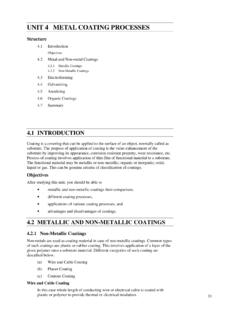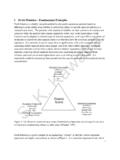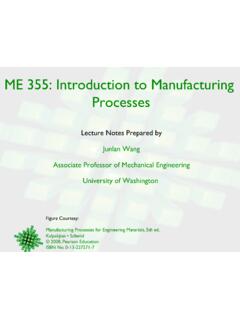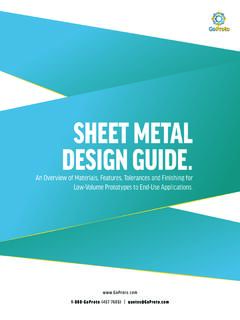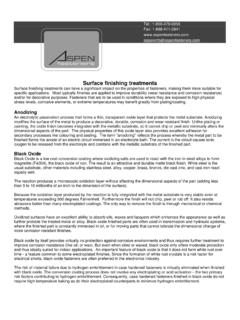Transcription of Tire Manufacturing Processes
1 Tire ManufacturingProcessesFor more information about tire defects, blowouts andtread separations contact the law offices of Kaster &Lynch, at (352) BELTED RADIAL PASSENGER AND LIGHT TRUCK TIRESMost steel belted radial passenger and light truck tires are composedof an inner liner, two polyester reinforced body plies, two steel beads, twobead reinforcing strips, two anti-chafing strips, two steel belts, with belt edgewedges or wrap around gum strips, the sidewalls, and the tread. Many tiresalso include one or two layers of nylon or polyester constricting belts or stripsover the steel belts (safety belts or cap plies).
2 See pictorial, Exhibit most common failure mode of steel belted radial passenger andlight truck tires is separation between the steel belt components. This areais subject to the highest amount of stress during normal use and is also thearea of weakest potential adhesion because of the difficulty of bonding rubberto metal and the mechanical stress at the belt edges. The adhesion can beadversely affected by various Manufacturing practices including, but notlimited to, under-curing, contamination, and improper storage and handlingof tire components.
3 For example, if any moisture is allowed to accumulate onsteel belt wire or between the steel belts, degradation of the steel wirecomponents or pockets of separation may occur. Similarly, small pockets ofair between the steel belts may result in a breakdown of adhesion. Lesscommon, but sometimes present, are foreign materials cured within the tiresuch as small pieces of metal, wood, or other contaminants. Contaminationfound in cured tires has varied widely, including perspiration, chicken bones,a live shotgun shell, a wrench, a glove, timecards, screws, etc.
4 Manufacturing PROCESST here are six basic Processes in the manufacture of of carbon blacks, elastomers and chemicals in the Banbury Mixer to form the rubber the fabrics and steel cord and coating them the treads and sidewall assembly of the green tire components on tire or curing the tire with heat and finishing, including inspection, storage and shipping. (Acertain portion of finished tires are also repaired in the finalfinishing process.)See pictorial, Exhibit belted radial tires incorporate as many as ten different ingredientswith the rubber compounds.
5 These compounds include antioxidants,antiozonants, curing agents, elastomers, sulfur reinforcing agents, cobalt,magnesium oxide, rubber polymers, calcium carbonate, zinc oxide, carbonblack, and processing materials. The compounds are prepared bymechanically mixing in a Banbury Mixer to mechanically break down therubber in an attempt to obtain a uniformly homogenous mass which issubsequently formed into slabs of rubber that are extruded or calendered foruse in tire building. The slabs of rubber produced are used to calender thebody plies, chafers, cap plies or edge strips, steel belts, and all other fabriccomponents used in the tire.
6 Some manufacturers also use a steelasticmachine to produce their fabric components. Slab stock is used for extrudedcomponents such as the sidewalls, treads, wedges and other solid rubberprofiled In the calendering process fabric cords and steel cords are coated withrubber stock. The rubber should be pressed between the individual twistedcord filaments which make up the steel belts. The body plies and reinforcingstrips incorporate polyester cord that is coated in an adhesive liquid. Thecord is passed between large heated rolls of a calendering machine.
7 A wovenfabric is similarly prepared and calendered for the anti-chafing strips. 4 Since rubber will not adhere to bare steel, the steel cord wires for thesteel belts are coated with a very thin layer of brass. These brass coated,rubber encased steel cords (multi-strand cables) become the steel belts. The brass coated steel wire is usually purchased from outside vendorsand shipped to the tire manufacturer in sealed containers to prevent moisturecontamination. When received by the manufacturer the wires should bestored in a temperature and humidity controlled environment until they arecoated with skim stock rubber in the calender.
8 It is critical that belt wire notbe exposed to moisture as it is susceptible to corrosion during themanufacturing process, which leads to a breakdown in adhesion. When the wires are removed from the shipping container they areplaced on roller apparatus in the creel room where temperature and humidityshould be controlled and continually monitored. The wire then passes fromthe creel room through the open plant to the calender. The distance from thecreel room to the calender varies among manufacturers ranging from 20 to 60feet.
9 The area of the plant between the creel room and calender is nothumidity and temperature controlled so that there is a potential for moistureto accumulate on the bare wire before it is encapsulated in rubber. This problem is exacerbated by slowdowns, temporary shutdowns,humidity spikes, and failure to adequately control temperature and humiditywithin the creel room. Once the belt wire becomes contaminated withmoisture, it becomes more difficult to obtain proper adhesion of the rubber tothe brass-coated wire.
10 The strongest possible bond between the rubber andthe belt wire is critical in the construction of steel belted radial steel wire passes from the creel room on rollers through aligningcombs into the calender where the wires are coated with a thin sheet of skimstock rubber. The rubber should also penetrate the steel cords for maximumadhesion. Both the polyester cords and steel cords are cut at specifiedangles and widths for use in tire tire components are formed by extrusion of uncured rubber,including tread and sidewall components.
